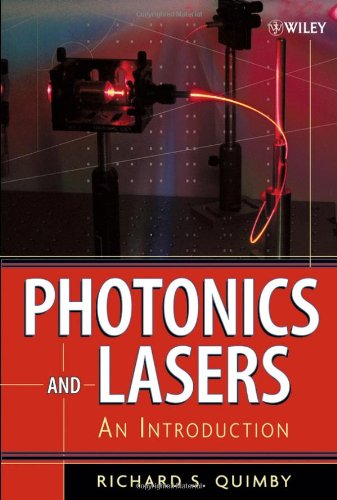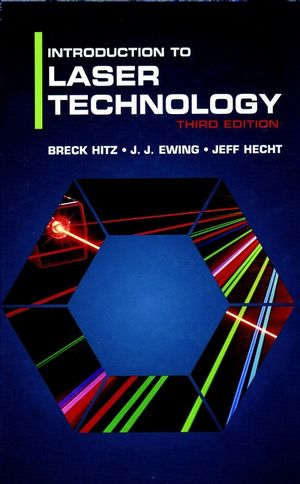Richard S. Quimby0471719749, 9780471719748, 9780471791584
Table of contents :
Photonics and Lasers……Page 3
Contents……Page 9
Preface……Page 13
1-1 Photonics Defined……Page 15
1-2 Fiber Optic Communications……Page 16
1-3 Overview of Topics……Page 18
2-1 The Nature of Light……Page 21
Phase and Group Velocity……Page 23
Energy in a Light Wave……Page 24
Snell’s Law……Page 25
Fresnel’s Equations……Page 26
Brewster’s Angle……Page 28
Total Internal Reflection……Page 29
Diffraction……Page 33
Interference……Page 34
2-4 Imaging Optics……Page 37
3-1 Waveguide Modes……Page 43
Effective Index……Page 47
Mode Velocities……Page 48
3-2 Mode Chart……Page 50
Field Distribution in a Mode……Page 52
3-3 Dispersion……Page 53
4-1 Acceptance Angle and Numerical Aperture……Page 57
Number of Modes……Page 60
Single-mode Fibers……Page 63
Mode Chart……Page 65
Gaussian Mode Approximation……Page 66
5-1 Absorption Loss……Page 69
Rayleigh Scattering……Page 71
Brillouin Scattering……Page 73
Raman Scattering……Page 74
5-3 Bending Losses……Page 76
Physical Optics View……Page 77
Mode Coupling……Page 79
Cladding Modes……Page 80
6-1 Graded Index Fiber……Page 83
Material Dispersion……Page 84
Waveguide Dispersion……Page 88
Polarization mode Dispersion……Page 89
Total Fiber Dispersion……Page 91
Fiber Connector……Page 93
Fiber Coupler……Page 94
7-2 Losses in Fiber Connections……Page 96
Multimode Fiber……Page 97
Single-Mode fiber……Page 98
Cutback Method……Page 99
Optical Time Domain Reflectometer……Page 100
Step-Index Grating……Page 107
Sinusoidal Index Grating……Page 111
Photonic Band Gap……Page 116
8-2 2-D Photonic Crystals……Page 120
Planar Geometry……Page 121
Fiber Geometry……Page 125
8-3 3-D Photonic Crystals……Page 131
9. Nonlinear Optics……Page 137
9-1 Fundamental Mechanisms……Page 138
Electron Cloud Distortion……Page 139
Other Nonlinear Mechanisms……Page 142
Second Harmonic Generation……Page 146
Three-Wave Mixing……Page 150
Four-Wave Mixing……Page 154
9-3 Nonlinear Refractive Index……Page 155
Optical Switching……Page 156
Pulse Chirping and Temporal Solitons……Page 158
Pulse Compression……Page 160
Self-Focusing and Spatial Solitons……Page 161
Pockels Effect……Page 163
Kerr Electrooptic Effect……Page 169
Energy Bands……Page 173
Energy and Momentum……Page 177
Radiative Efficiency……Page 181
10-2 Layered Semiconductors……Page 184
The p–n Junction……Page 185
Semiconductor Heterojunctions: The Quantum Well……Page 191
Metal–Semiconductor Junctions……Page 192
Biasing and Optical Power……Page 199
Time and Frequency Response……Page 201
Emission Efficiency……Page 205
Properties of Lasers……Page 209
Types of Semiconductor Lasers……Page 214
12-1 Point Source……Page 229
12-2 Lambertian Source……Page 230
12-3 Laser Source……Page 233
Time Response……Page 237
Thermoelectric Detector……Page 239
Pyroelectric Detector……Page 240
Photoelectric Effect……Page 242
Vacuum Photodiode……Page 244
Photomultiplier……Page 248
Photoconductive Detectors……Page 250
13-3 Noise in Photon Detectors……Page 255
Shot Noise……Page 256
Johnson Noise……Page 258
14-1 Biasing the Photodiode……Page 263
Photovoltaic Mode……Page 267
Photoconductive Mode……Page 270
Junction Capacitance……Page 273
Carrier Transit Time……Page 276
PIN Photodiode……Page 278
Avalanche Photodiode……Page 281
Schottky Photodiode……Page 286
14-5 Signal-to-Noise Ratio……Page 287
14-6 Detector Circuits……Page 289
Transimpedance Amplifier……Page 290
15-1 Overview of Laser Operation……Page 295
15-2 Optical Coherence……Page 296
Temporal Coherence……Page 297
Spatial Coherence……Page 300
Brightness……Page 302
1-D Treatment……Page 307
3-D Treatment……Page 310
Photon Lifetime……Page 312
Quality Factor Q……Page 314
Cavity Finesse……Page 315
16-3 Fabry-Perot Interferometer……Page 316
17-1 Gaussian Beams in Free Space……Page 321
Intensity Distribution……Page 322
Peak Intensity……Page 323
17-2 Gaussian Beams in a Laser Cavity……Page 325
Stability Criterion in Symmetric Resonator……Page 326
Stability Criterion in an Asymmetric Resonator……Page 327
Higher-Order Modes……Page 328
17-3 Gaussian Beams Passing Through a Lens……Page 332
Gaussian Beam Focusing……Page 333
Gaussian Beam Collimation……Page 336
Broadband Radiation……Page 341
Narrowband Radiation……Page 347
Gain Coefficient……Page 351
Gain Cross Section……Page 354
Fluorescence Lifetime……Page 357
Quantum Yield……Page 359
Lineshape Function……Page 361
Rate Equation Approach……Page 365
Gain Saturation……Page 368
19-2 Total Gain of Amplifier……Page 370
Small Signal Gain……Page 371
Large Signal Gain……Page 372
Amplifier Gain: General Case……Page 374
20-1 Threshold Condition……Page 379
Rate Equation Approach……Page 382
Steady-State Laser Output……Page 384
Laser Output Efficiency……Page 386
Multimode Lasing……Page 395
Achieving Single-mode Lasing……Page 399
Tuning the Laser Wavelength……Page 402
22-1 Uncontrolled Pulsing……Page 407
22-3 Theory of Q-Switching……Page 409
22-4 Methods of Q-Switching……Page 411
Electrooptic Shutter……Page 412
Acoustooptic Shutter……Page 413
Passive Q-Switching……Page 415
Two Lasing Modes……Page 416
N Lasing Modes……Page 417
Pulse Width……Page 419
Pulse Repetition Time……Page 421
22-6 Methods of Mode Locking……Page 423
Passive Mode Locking……Page 424
Electronic Transition……Page 429
Fiber Lasers……Page 439
Vibronic Transition……Page 450
23-2 Electrically Pumped Lasers……Page 454
Electronic Transition……Page 455
Vibrational Transition……Page 461
24-1 Fiber Optic Communications Systems……Page 467
Data Format……Page 469
Time Division Multiplexing……Page 472
Wavelength Division Multiplexing (WDM)……Page 473
24-3 Power Budget in Fiber Optic Link……Page 478
Receiver Sensitivity……Page 479
Maximum Fiber Length……Page 483
24-4 Optical Amplifiers……Page 486
Erbium-doped Fiber Amplifier (EDFA)……Page 487
Other Optical Amplifiers……Page 494
24-5 Free-Space Optics……Page 501
Bibliography……Page 507
Appendix A Solid Angle and the Brightness Theorem……Page 509
Appendix B Fourier Synthesis and the Uncertainty Relation……Page 513
List of Symbols……Page 519
Index……Page 525







Reviews
There are no reviews yet.